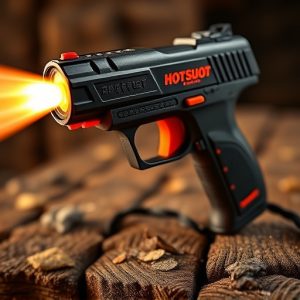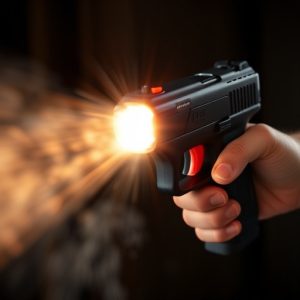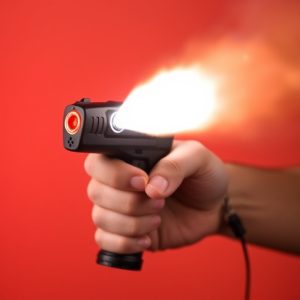Non-Lethal Weapon Certification: Hot Shot Stun Guns & Training Guide
The text explores the rising popularity of hot shot stun guns as a safe and effective personal defen…….
The text explores the rising popularity of hot shot stun guns as a safe and effective personal defense tool, ideal for law enforcement and private security. These electronic control devices (ECDs) temporarily disable targets without causing permanent harm. It highlights key features to consider when purchasing, such as power output, range, and ease of use. The article also discusses the importance of legal considerations and storage options, as well as the eligibility requirements and training processes for obtaining a non-lethal weapon certification. These certified weapons offer significant advantages in various sectors, including crowd control, asset protection, and bear deterrence.
“Uncover the power of non-lethal weapons with our comprehensive guide, designed to equip individuals and professionals with vital knowledge. We explore the growing significance of alternative force tools, particularly Hot Shot stun guns, in modern security and self-defense scenarios. From eligibility criteria to the certification process, this article navigates the key aspects.
Learn about the benefits and diverse applications of certified non-lethal weapons, offering a safer yet effective approach to conflict resolution, especially when facing highly aggressive individuals.”
- Understanding Non-Lethal Weapon Certification: A Comprehensive Guide
- The Rise of Hot Shot Stun Guns: What You Need to Know
- Eligibility Requirements for Non-Lethal Weapon Training
- The Process: Obtaining Your Non-Lethal Weapon Certification
- Benefits and Applications of Certified Non-Lethal Weapons
Understanding Non-Lethal Weapon Certification: A Comprehensive Guide
The Rise of Hot Shot Stun Guns: What You Need to Know
In recent years, there’s been a noticeable shift in non-lethal weapon technology with the rise of hot shot stun guns. These innovative devices are gaining popularity among law enforcement agencies and private security firms alike due to their effectiveness in de-escalating potentially dangerous situations. Hot shot stun guns, also known as electronic control devices (ECDs), use electric current to temporarily disable a target, offering a safer alternative to traditional firearms.
The advent of hot shot stun guns comes with significant advantages. They allow officers to subdue an assailant without causing permanent harm, making them invaluable in situations where the primary goal is to neutralize a threat and avoid fatal force. As technology advances, these devices are becoming more compact, powerful, and user-friendly, ensuring that those trained in their use can respond swiftly and effectively to various security challenges.
Eligibility Requirements for Non-Lethal Weapon Training
To enroll in non-lethal weapon training, candidates must meet specific eligibility requirements that ensure safety and proficiency. Often, this includes being at least 21 years old, as well as possessing a valid government-issued photo ID. Physical fitness is another crucial factor; candidates should be in good health and possess the necessary strength and agility to handle non-lethal weapons effectively. Background checks are standard procedure to ensure individuals seeking training have no disqualifying criminal history.
Additionally, some courses may require basic firearms training or experience, as familiarity with weapon handling procedures is essential. In many jurisdictions, a clean driving record might also be demanded. For instance, those interested in learning about hot shot stun guns should anticipate these prerequisites before signing up for certification programs to ensure a smooth and beneficial training experience.
The Process: Obtaining Your Non-Lethal Weapon Certification
Obtaining a non-lethal weapon certification is a crucial step for individuals seeking to carry and use devices like the Hot Shot Stun Gun responsibly and legally. The process typically begins with thorough research into local and regional regulations governing stun guns, as laws can vary widely. Potential users must identify their state’s specific requirements, including any necessary permits or licenses.
Next, applicants enroll in an accredited training program that covers both theoretical knowledge and practical application. This involves attending workshops, studying manual instructions, and participating in hands-on demonstrations using the Hot Shot Stun Gun. Successful completion of this training leads to certification, empowering users to deploy their stun guns effectively while adhering to legal and safety protocols.
Benefits and Applications of Certified Non-Lethal Weapons
Certified non-lethal weapons, such as the Hot Shot Stun Gun, offer a range of benefits and versatile applications in various sectors. One of the primary advantages is their ability to incapacitate or deter individuals without causing permanent harm or fatal injuries. This is particularly valuable for law enforcement agencies, security personnel, and private citizens seeking self-defense options. By using non-lethal force, professionals can de-escalate potentially dangerous situations, ensuring the safety of both suspects and officers.
In practical terms, these certified weapons are designed to disrupt muscle control and cause temporary paralysis, allowing for quick restraint and neutralization. They are effective in crowd control during protests or civil disturbances, providing an alternative to traditional lethal force. Additionally, hot shot stun guns can be utilized by security guards to protect valuable assets, by personal protection officers for high-risk clients, and even by outdoor enthusiasts for bear deterrence, showcasing their wide-ranging utility and appeal.
In light of growing concerns for public safety and the need for non-lethal force options, understanding and obtaining non-lethal weapon certification has become increasingly important. This article has provided a comprehensive guide to navigating the process, from clarifying key terms like hot shot stun guns to outlining eligibility requirements and the benefits of certified non-lethal weapons. By exploring these aspects, individuals and organizations can make informed decisions about adopting non-lethal force solutions for various applications, enhancing safety while adhering to responsible use guidelines.


